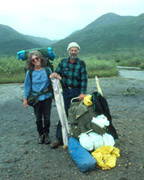Rites of Spring
©Bert Gildart: Birds and flowers, that’s what’s making headlines now in Arizona’s Organ Pipe National Monument. Flowers, we’ve been told, are beginning to emerge all along the Ajo Mountain Drive, and we plan to make that drive in another day or so. Because I have some business to attend to, we’re staying close to our Airstream, parked now at the Twin Peaks Campground, and here, near our parking site we’re seeing lots of bird life.

Courtship time and this fellow may be trying to impress the females with various vocal and visual antics
One of the species I’ve been able to photograph is the raven. Over the years I’ve made lots of portraits, so I’m now trying for something more, something that great suggests intelligence.
GREAT INTELLIGENCE
Intelligence, of course, is expressed in different ways, and the literature is full of examples. One example is provided in a book Janie recently gave me-appropriately entitled The Raven, by Lynn Hassler. Though the book provides many examples one tells of a raven finding a bucket during a time of drought. Liquid in the bucket needed to be raised and the raven accomplished that by dropping stones into the bucket.
Communication, however, may be the best example of a raven’s intelligence, and scientists say the bird has dozens of different forms of vocalization. Yesterday, using a long lens, I photographed this one on top of a saguaro cactus, and though I certainly don’t know precisely what the flared tail feather and accompanying croak signifies, I suspect it was expressing anger. “Stay out, stay out,” he may have been telling some of the other ravens flying about. “Stay out! This is my territory.” For added emphasis, the bird flares its nictitating membrane, a membrane that registers alabaster in my photo and which is designed to protect the bird’s eye from foreign objects, easily picked up while in flight.
HUMMINGBIRDS
Other birds are also making their presence known and this male Costa’s hummingbird was busy chasing other male Costa’s, apparently in an attempt to establish his territory.
Naturalists at the visitor center say hummingbirds have not yet nested here. As some of you may recall I recently posted photographs of either the Anna’s or the Costa’s nesting in Anza Borrego. ID-ing females is difficult, but not so the males. Note the “bib,” on this little fellow, confirming that it is an Costa’s .
THIS TIME LAST YEAR
*Marta Becket’s Amargosa Opera House


